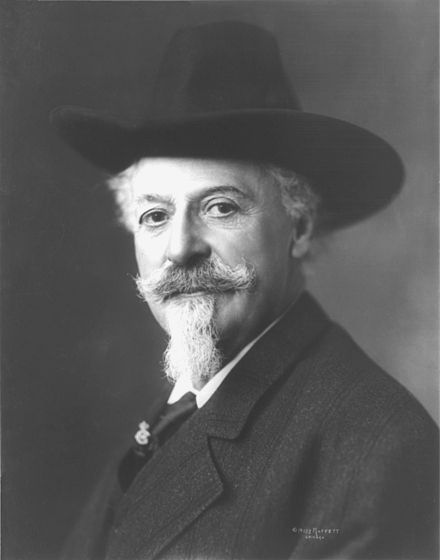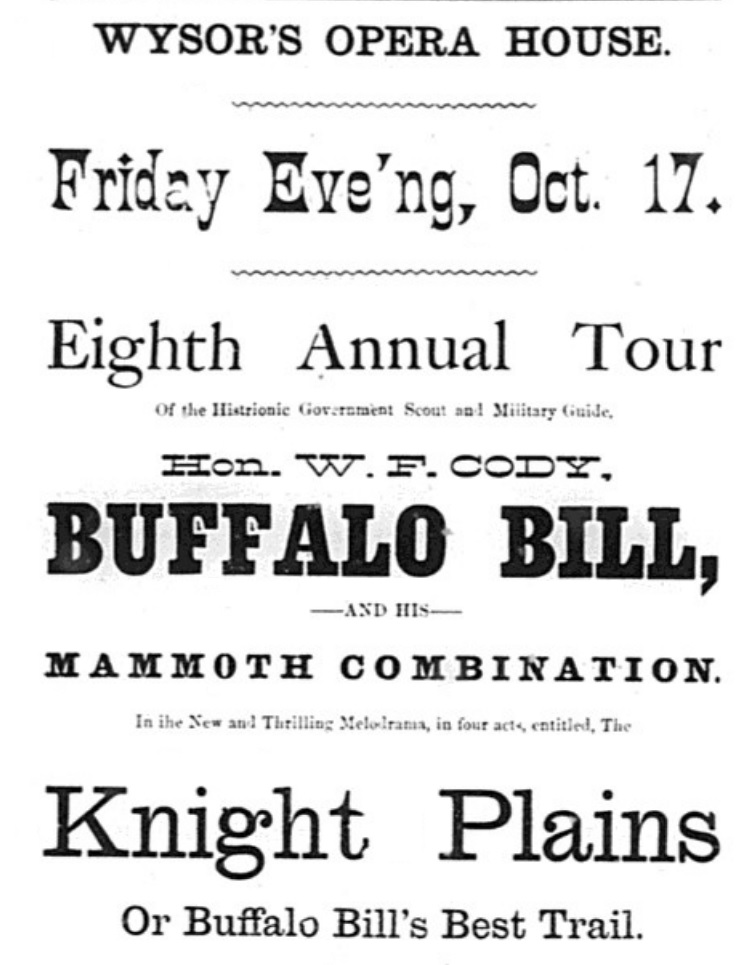
Photo Credit: Wikipedia.com

Buffalo Bill. The name alone brings to mind a rootin’ tootin’ shootin’ extravaganza of Wild West action. Touring across the nation, William F. Cody propelled himself from to army scout to legendary showman. Among the stops on the cowboy’s itinerary was our little town on the river.
On October 17, 1879, Buffalo Bill and his “Mammouth Combination”, as his attraction was called, appeared at Wysor’s Opera House. An afternoon parade whetted everyone’s appetite for excitement, as if five days of front page advertising two columns wide had not gotten the attention of locals. The parade would be a bit of a feat in itself since the entourage had performed the previous night in North Vernon, some ninety miles away. The newspaper assured ladies that the show was in no way offensive and that the report of Bill’s rifle was not loud.

At nine o’clock, the curtains opened to a full house and the Knight of the Plains began. The four act play written by Col. Prentiss Ingraham featured Cody playing a different lead character in each segment. The roles included Bill as himself, an English nobleman, Detective Lord Edmondstone Howard, and a Pony Express rider. Within the play, attendees were introduced to a “band of genuine Indian chiefs” as well as to Henry E. “Eddie” Burgess AKA Pe-risk-y-la-shar, referred to as the “Boy Chief of the Pawnees”. Eddie’s brother, C. A. “Charlie” Burgess, was listed in the media as a U. S. scout and interpreter. Following the play, spectators were treated with a display of “pre-eminent and unrivaled” shooting abilities.
November 22, 1881, Bill and his ‘combination’ returned to the opera house. Other than a few single-line mentions in the City News column, the event went largely noticed on the front page. The back page did have a two-column advertisement, but it was not even half the length of the page. Eddie Burgess was a returning act joined by He-nu-kaw, “the handsomest Indian girl in the world”, and Flying Cloud, the oldest Sioux war chief. The play was The Prairie Waif written by John A. Stevens.
Cody and his entourage, then known as Buffalo Bill’s Wild West, arrived for the August 4, 1899, down one player. One of the Rough Riders had been taken to the hospital in Lima for typhoid. It is noted that rain was heavy in town with a lot of thunder and lightning so the lot at Wysor and Madison Streets was a mess. The arena there was 174 x 382 and he described business as “fair” even despite the wet conditions. Cody mentions in his journal, that Fred “Fritz” Hoffman was sent to the hospital with a broken leg. On Saturday, the troupe caught the L. E. & W. 65 to Fort Wayne. The show's bad luck followed them on to Allen County where Little Mary, an Indian baby, died.
Even worse luck was around the corner for flamboyant entertainer. A 1901 railroad accident resulted in the deaths of one hundred and ten of the show’s horses. While no people were killed, Ohio native and shooting legend, Annie Oakley was seriously injured. Bill stuggled to get the show back on its feet after the crash. Several very successful tours of Europe lifted the old scout to international fame and resuscitated interest in the show stateside. Eventually, he and his various troupes of performers of the Wild West Show, and later in conjunction with the Sells-Foto Circus, returned to Muncie four more times: August 27, 1907; June 5, 1908; July 9-10, 1911; and September 19, 1914.
William F. “Buffalo Bill” Cody passed away in 1917. The Pony Express rider, Civil War veteran, army scout civilian recipient of the Congressional Medal of Honor, leaving an indelible memory in the minds of spectators word-wide.
© On The Banks Of White River/Jennifer Lewis 2015
[This article appeared in the Delaware County (Indiana) Historical Society Newsletter, May/June, 2015]